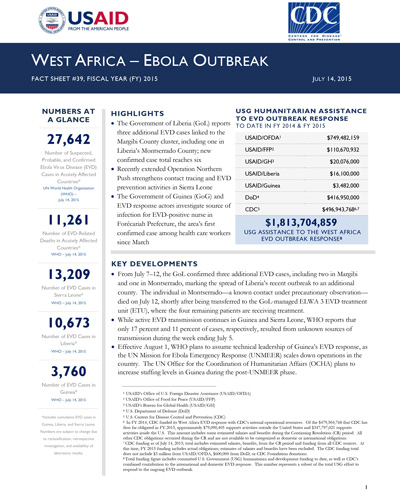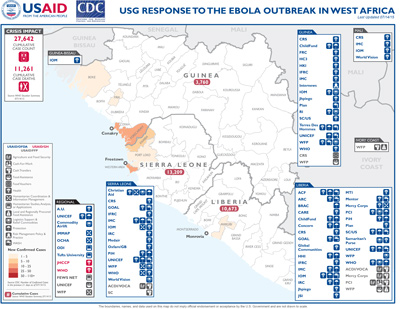Speeches Shim
July 14, 2015
HIGHLIGHTS
Ebola Response
Visit our main West Africa Ebola Outbreak page to learn more about how we're responding to the West Africa Ebola outbreak, and what you can do to help.
- The Government of Liberia (GoL) reports three additional EVD cases linked to the Margibi County cluster, including one in Liberia’s Montserrado County; new confirmed case total reaches six
- Recently extended Operation Northern Push strengthens contact tracing and EVD prevention activities in Sierra Leone
- The Government of Guinea (GoG) and EVD response actors investigate source of infection for EVD-positive nurse in Forécariah Prefecture, the area’s first confirmed case among health care workers since March
West Africa Ebola Outbreak Fact Sheet #39 ![]() (pdf - 365k)
(pdf - 365k)
KEY DEVELOPMENTS
- From July 7–12, the GoL confirmed three additional EVD cases, including two in Margibi and one in Montserrado, marking the spread of Liberia’s recent outbreak to an additional county. The individual in Montserrado—a known contact under precautionary observation— died on July 12, shortly after being transferred to the GoL-managed ELWA 3 EVD treatment unit (ETU), where the four remaining patients are receiving treatment.
- While active EVD transmission continues in Guinea and Sierra Leone, WHO reports that only 17 percent and 11 percent of cases, respectively, resulted from unknown sources of transmission during the week ending July 5.
- Effective August 1, WHO plans to assume technical leadership of Guinea’s EVD response, as the UN Mission for Ebola Emergency Response (UNMEER) scales down operations in the country. The UN Office for the Coordination of Humanitarian Affairs (OCHA) plans to increase staffing levels in Guinea during the post-UNMEER phase.
REGIONAL
Between June 29 and July 5, WHO reported 30 confirmed cases of EVD in West Africa, including 18 cases in Guinea, nine cases in Sierra Leone, and three cases in Liberia. During the same period, five cases—or approximately 17 percent of newly confirmed cases—resulted from unknown sources of infection, indicating improvements in case investigations and understanding of chains of transmission, according to WHO.
In partnership with the African Development Bank, the African Union (AU), the E.U., and the World Bank, the UN hosted an International Ebola Recovery Conference in New York from July 9–10. Following technical consultations for recovery strategies, the international community pledged more than $5 billion on July 10 to support longterm recovery efforts in Guinea, Liberia, and Sierra Leone.
West Africa Ebola Map #39 July 14, 2015 ![]() (pdf - 527k)
(pdf - 527k)
Through more than $6.4 million in assistance, USAID/FFP is supporting UNICEF’s efforts to prevent and treat severe and moderate acute malnutrition among EVD-affected children in Guinea, Liberia, and Sierra Leone. UNICEF will conduct screenings, referral, and treatment of severe acute malnutrition (SAM) and moderate acute malnutrition (MAM) among children in communities throughout the three EVD-affected countries. In addition, the UN agency plans to treat approximately 50,000 children younger than five years of age affected by SAM and MAM with ready-to-use therapeutic and supplementary food and nutritional supplements.
Liberia
On July 12, the GoL Incident Management System (IMS) confirmed an additional EVD case, the sixth in the country since June 29. The latest confirmed EVD patient was on an existing contact list but resided in Montserrado, marking the spread of the current cluster from Margibi to a second county. The patient was admitted to the ELWA 3 ETU on July 12 and died there the same day. Of the six cases associated with Liberia’s current EVD cluster, two patients have died and four are receiving treatment at Montserrado’s ELWA 3 ETU. WHO reports that as of July 10, EVD response actors are monitoring 149 contacts, including the four patients receiving treatment at ELWA 3 ETU. Counties in Liberia remain on alert and are reporting suspected EVD cases to the GoL IMS.
According to WHO, laboratory tests on virus samples from the first-detected Margibi case indicate that the strain appears to be genetically similar to those that affected the area more than six months ago, indicating that the current outbreak likely did not result from an animal source, nor from infections in neighboring Guinea or Sierra Leone. Genetic sequencing on samples from subsequent cases is underway.
USAID/OFDA, CDC, and other EVD response actors in Margibi and Montserrado continue to support response efforts, including contact tracing, case investigation, safe burials, social mobilization campaigns, and surveillance and monitoring. CDC field epidemiologists remain actively engaged in case investigation and contact tracing, while also providing training for Montserrado County Health Team and WHO-supported groups of contact tracers and case investigators. In addition, USAID/OFDA partner Global Communities resupplied the two burial teams in Margibi with chlorine sprayers and transferred an additional team to the ELWA 3 ETU in Montserrado. The non-governmental organization also provided food assistance to health care workers under observation in Margibi and continues to support health-monitoring checkpoints along the border counties.
USAID/OFDA partner IOM continues to provide EVD response assistance—including surveillance, coordination, and capacity building; psychosocial services and survivor reintegration; and social mobilization support—to multiple affeted counties in Liberia. Between July 3 and 10, IOM supported official and unofficial county and national border crossing points and county checkpoints, delivered triage materials, and held refresher infection prevention and control trainings. In response to the recent cluster of new confirmed EVD cases in Margibi and Montserrado, IOM is working to scale up checkpoint support and social mobilization activities in and near the affected counties.
Sierra Leone
Between July 6 and 12, the Government of Sierra Leone (GoSL) Ministry of Health and Sanitation (MoHS) confirmed 14 new EVD cases, including 10 in Western Area Urban District, three in Kambia District, and one in Port Loko District—which had not reported a new EVD case since July 2. Ten of the EVD cases came from known contacts, while four cases resulted from an unknown contact.
Operation Northern Push—which the GoSL recently extended beyond its initial 21-day campaign period ending July 7— has expanded social mobilization activities, harnessed community support, improved contact tracing, and effectively monitored the prevention of EVD transmission from Guinea, according to response actors. For example, the National Ebola Response Center reported that in Kambia, EVD response actors have strengthened case finding efforts, and in Port Loko, authorities reported on July 8 that increased contract tracing has helped identify a number of missing contacts. In addition, social mobilization messaging across Kambia and Port Loko continues to dispel rumors surrounding EVD response activities, encourage communities to report suspected cases, and promote good EVD prevention practices.
With support from USAID/OFDA, Medair is strengthening peripheral health units (PHUs) in Sierra Leone’s Western Area. The organization completed baseline assessments at five PHUs regarding capacity, services offered, and physical structures. Medair also assisted in drafting work plans specific to the PHUs and placing orders for essential supplies. In addition, the organization liaised with the GoSL MoHS to coordinate official Integrated Management of Neonatal and Childhood Illnesses training for 14 PHU staff members.
USAID/FFP continues to provide agricultural and nutritional assistance to EVD-affected populations throughout Sierra Leone. Together with PHUs and mother care groups, USAID/FFP partners ACDI/VOCA and IMC are training mothers to screen their children using the mid-upper arm circumference method. The at-home screenings help to promote more timely detection, referral, and treatment of moderate and severe acute malnutrition in EVD-affected communities. In addition, ACDI/VOCA has provided seeds to approximately 25,000 farmers to support agricultural cultivation and production during the 2015/2016 crop cycle, thus assisting households to recover from the negative impact of EVD on agricultural production and incomes.
Guinea
The GoG reported 13 new confirmed EVD cases during the week ending July 12, a nearly 28 percent decrease from the previous week. The recently confirmed cases include nine cases from Guinea’s capital city of Conakry, three cases from Forécariah Prefecture, and one case from Fria Prefecture. According to prefectural authorities, the new case reported in Fria—a known contact from Kamsar sub-prefecture located in Boké Prefecture—evaded contact tracing teams in Kamsar and fled to Fria, where the individual was later discovered. On July 11, EVD response actors transferred the case to Boké’s newly opened ETU for treatment.
On July 10, the GoG reported that all remaining contacts of the last confirmed case in Dubréka Prefecture had surpassed the 21-day active monitoring period. Four prefectures―Boké, Conakry, Forécariah, and Fria―continue to have active chains of transmission.
Prefectural authorities in Forécariah reported on July 10 that a French Red Cross (FRC) nurse had tested positive for EVD. According to FRC, the nurse—who was not a known contact— is receiving care at the Forécariah ETU, and an investigation to determine the source of infection remains ongoing. Since the outbreak began, prefectural authorities have reported 12 confirmed EVD cases, including two community deaths, among health care workers in Forécariah; the last confirmed health care worker infection in the prefecture occurred in March. As of July 13, the National Ebola Coordination Cell reported that 207 health care workers across Guinea had contracted EVD since the start of the EVD outbreak in the country.
WHO plans to assume technical leadership of the EVD response in Guinea by August 1, as UNMEER scales down its national operations. A small contingent of UNMEER staff, including the Ebola Crisis Manager for Guinea, will remain in-country to support regional coordination and ongoing EVD response efforts under WHO authority. OCHA plans to increase staffing levels in Guinea to ensure a strong presence in the field and sufficient staff levels to support its expanded coordination function during the post-UNMEER phase.
USG Disaster Assistance Response Team (DART) staff traveled to Guinea’s Kankan Region from July 2–3 to monitor ongoing social mobilization and communication activities implemented by USAID/OFDA partners Helen Keller International (HKI) and Save the Children. During the visit, the DART met with prefectural and regional authorities, attended a HKI training on EVD preparedness measures and conducted site visits to three public health centers and Kankan’s regional hospital. As of July 3, HKI, in support of local authorities, had begun training 30 supervisors from three of the region’s five prefectures to coordinate the local EVD response efforts and oversee community agents operating in the area.
From July 3–5, DART and CDC staff traveled to Boké to engage with representatives of the Center for International Studies and Cooperation (CECI) and UN Children’s Fund (UNICEF) on strengthening social mobilization activities in the prefecture. During the visit, the joint USAID/OFDA–CDC team also conducted an informal assessment on community-level EVD awareness and social mobilization activities in Boké’s Port Kamsar city and Binari Island. Following the visit, the DART presented key findings regarding gaps in community knowledge of EVD transmission from the informal assessment during a meeting of the National Ebola Coordination Cell’s communication unit and urged response actors to ensure that EVD messaging is context-specific and achieves measurable results.
PUBLIC DONATION INFORMATION
- The most effective way people can assist relief efforts is by making cash contributions to humanitarian organizations that are conducting relief operations. A list of humanitarian organizations that are accepting cash donations for disaster responses around the world can be found at www.interaction.org.
- USAID encourages cash donations because they allow aid professionals to procure the exact items needed (often in the affected region); reduce the burden on scarce resources (such as transportation routes, staff time, and warehouse space); can be transferred very quickly and without transportation costs; support the economy of the disaster-stricken region; and ensure culturally, dietary, and environmentally appropriate assistance.
More information can be found at:
- The Center for International Disaster Information: www.cidi.org or +1.202.821.1999.
- Information on relief activities of the humanitarian community can be found at www.reliefweb.int.
USAID/OFDA bulletins appear on the USAID website at what-we-



Comment
Make a general inquiry or suggest an improvement.